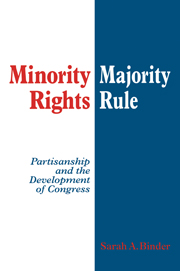Book contents
- Frontmatter
- Contents
- List of tables and figures
- Preface
- 1 The partisan basis of procedural choice
- 2 The evolving concepts of House and Senate minority rights
- 3 Procedural choice in the early Congress: The case of the “previous question”
- 4 Allocating minority rights in the House, 1789–1990
- 5 Institutionalizing party in the nineteenth-century House
- 6 Stacking the partisan deck in the twentieth-century House
- 7 Inherited rules and procedural choice in the Senate
- 8 Assessing the partisan theory
- Appendix 1 Summary of changes in minority rights
- Appendix 2 Measuring congressional workload
- Appendix 3 Measuring party behavior
- Bibliography
- Index
Appendix 2 - Measuring congressional workload
Published online by Cambridge University Press: 10 December 2009
- Frontmatter
- Contents
- List of tables and figures
- Preface
- 1 The partisan basis of procedural choice
- 2 The evolving concepts of House and Senate minority rights
- 3 Procedural choice in the early Congress: The case of the “previous question”
- 4 Allocating minority rights in the House, 1789–1990
- 5 Institutionalizing party in the nineteenth-century House
- 6 Stacking the partisan deck in the twentieth-century House
- 7 Inherited rules and procedural choice in the Senate
- 8 Assessing the partisan theory
- Appendix 1 Summary of changes in minority rights
- Appendix 2 Measuring congressional workload
- Appendix 3 Measuring party behavior
- Bibliography
- Index
Summary
A single perfect measure of the level of demands on Congress over time does not exist. Ideally, if we wanted to know whether the amount of time consumed by legislative activity in committee and on the floor led members to alter the array of procedural rights, we would assemble data on the amount of time spent in committee and on the floor, and on the number of bills, amendments, and routine legislative matters considered in both. Because not all legislative business exacts the same toll on all members and in both chambers, we would also ideally have a method of weighting bills and amendments by their salience and complexity. Such measures might provide a reasonably valid and reliable measurement of the scope of the congressional agenda. Short of these meters of workload – particularly for the period before 1945 – alternative measures are needed.
Because no single measure of legislative activity will fully capture the level and scope of legislative demands faced in each chamber, I instead take several different approaches to measuring workload. The first approach assembles several separate indicators of congressional activity for the early period (1789–1823) assessed in Chapter 3. For the House, I count from the House Journal the number of bills (public and private) originating in and passed by the House and the number of bills (public and private) introduced in the House in each Congress.
- Type
- Chapter
- Information
- Minority Rights, Majority RulePartisanship and the Development of Congress, pp. 218 - 219Publisher: Cambridge University PressPrint publication year: 1997



